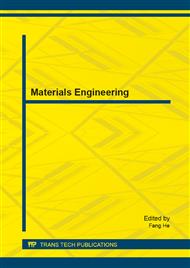[1]
W.P. Sun, L.T. Yan, B. Lin, S.Q. Zhang and W. Liu: High performance proton-conducting solid oxide fuel cells with a stable Sm0. 5Sr0. 5CoO3-Ce0. 8Sm0. 2O2 composite cathode. J Power Sources Vol. 195 (2010), p.3155.
DOI: 10.1016/j.jpowsour.2009.11.100
Google Scholar
[2]
Y. Vural., L. Ma, D.B. Ingha, M, and Pourkashanian: Comparison of the multicomponent mass transfer models for the prediction of the concentration overpotential for solid oxide fuel cell anodes. J. Power Sources Vol. 195 (2010), p.4893.
DOI: 10.1016/j.jpowsour.2010.01.033
Google Scholar
[3]
L. Zhao, B.B. He, and C.R. Xia: Reaction model for cathodes cooperated with oxygen-ion conductors for solid oxide fuel cells using proton-conducting electrolytes. Int J Hydrogen Energ Vol. 37 (2012), p.548.
DOI: 10.1016/j.ijhydene.2011.09.084
Google Scholar
[4]
M. Ni, M.K. H/. Leung and D.Y.C. Leung: Mathematical Modeling of Proton-Conducting Solid Oxide Fuel Cells and Comparison with Oxygen-Ion-Conducting Counterpart. FUEL CELLS Vol. 4 (2007), p.269.
DOI: 10.1002/fuce.200600049
Google Scholar
[5]
M. Ni., D.Y.C. Leung and M.K. H Leung: Electrochemical modeling and parametric study of methane fed solid oxide fuel cells. Energy Convers Manage Vol. 50 (2009), p.268.
DOI: 10.1016/j.enconman.2008.09.028
Google Scholar
[6]
H.Y. Zhu. and R.J. Kee: A general mathematical model for analyzing the performance of fuel-cell membrane-electrode assemblies. J. Power Sources Vol. 117 (2003), p.61.
DOI: 10.1016/s0378-7753(03)00358-6
Google Scholar
[7]
R.C. Reid., J.M. Prausnitz and T.K. Sherwood: The properties of gases and liquids. (McGraw-Hill, New York 1977).
Google Scholar
[8]
B. Todd, and J.B. Young: Thermodynamic and transport properties of gases for use in solid oxide fuel cell modelling. J. Power Sources Vol. 110 (2002), p.186.
DOI: 10.1016/s0378-7753(02)00277-x
Google Scholar
[9]
F. Calise, G. Ferruzzi and L. Vanoli: Parametric exergy analysis of a tubular Solid Oxide Fuel Cell (SOFC) stack through finite-volume model. Appl Energy Vol. 86 (2009), p.2401.
DOI: 10.1016/j.apenergy.2009.03.024
Google Scholar
[10]
M. Andersson, J.L. Yuan, B. Sundén: Review on modeling development for multiscale chemical reactions coupled transport phenomena in solid oxide fuel cells, Appl Energy Vol. 87 (2010), p.1461.
DOI: 10.1016/j.apenergy.2009.11.013
Google Scholar
[11]
L. Yang, C.D. Zuo, M.L. Liu: High-performance anode-supported Solid Oxide Fuel Cells based on Ba(Zr0. 1Ce0. 7Y0. 2)O3 (BZCY) fabricated by a modified co-pressing process. J Power Sources Vol. 195 (2010), p.1845.
DOI: 10.1016/j.jpowsour.2009.10.018
Google Scholar


